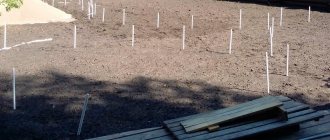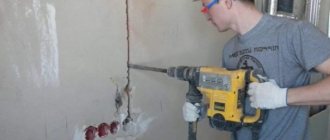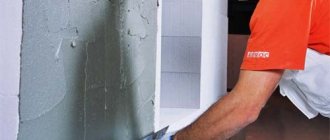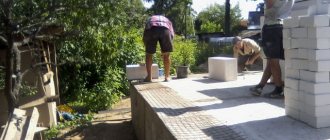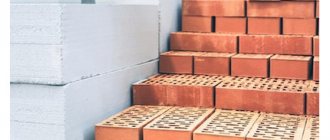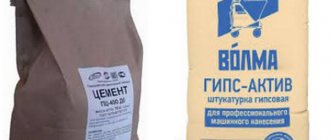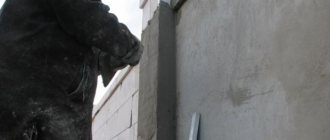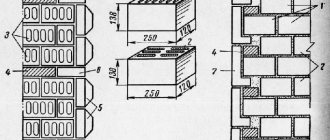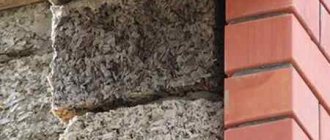Private construction from lightweight expanded clay concrete compositions, various porous gas and foam blocks, large-format gas silicate elements is becoming increasingly popular for a number of reasons. However, the technology for plastering aerated concrete walls is somewhat different from the methods for processing brick and wooden bases.
This article will discuss the basic requirements for finishing compounds for plastering different types of concrete, criteria for their selection, application technologies and proportions for self-production.
Types of plasters for aerated concrete blocks
Rice.
1. Types of plaster for aerated concrete and aerated silicate We choose what to plaster aerated concrete with to ensure the required properties - protection from temperature changes, weather resistance, excellent adhesion:
- Gypsum plaster for aerated concrete with perlite sand. Compatible with all finishing materials. It dries quickly, does not shrink, and allows you to make the surface as smooth as possible. No finishing coat required. Cons: high water consumption. A bag takes up to 15 liters. It should not be used outside as it does not withstand precipitation well.
- Cement is heavier and will not work without lime components. Therefore, a combined composition of cement, lime and additives is used.
- Silicate is made on the basis of potassium liquid glass. It is durable, moisture resistant, and easy to apply. Provides resistance to abrasion and dirt. The service life can reach 25 years.
- Silicone based on organosilicon polymers, resins. Provides strength and elasticity, protecting against cracking even during shrinkage. A good solution for facades. The downside is the higher price compared to other types.
The most popular manufacturers are Ceresit (mixtures CT 24 and 77), Osnovit (Startwell T-21), Baumit, Weber.pas. These products are certified according to modern standards and are of high quality and reliability.
We described in detail about other types of plaster here.
Step-by-step instruction
Step-by-step instructions will help you correctly complete the finishing yourself or monitor hired workers, because they may miss important steps. Failure to do so can result in destruction of the surface of the finishing layer.
Worker plastering a wall
How to prepare the surface
First of all, prepare the walls:
- Visually inspect the surface, identifying defects in the masonry.
- Remove any glue that has protruded from the seams with a chisel, a bricklaying hammer or any other suitable tool. Skipping a step entails unnecessary consumption of expensive plaster mixture, since you will have to use a thick leveling layer.
- Shallow chips, potholes, dents, and voids in the seams are repaired with masonry adhesive; for large defects, repair compounds are used.
- The walls are coated with a deep penetration primer in 2-3 layers, following the operating instructions - the temperature of the air and blocks, the time between application of layers, etc. Wide brushes, rollers, and sprayers are used for application.
Primer of walls
After the primer has completely dried, you can continue working. To reduce primer consumption, before application the wall can be sprayed with clean water to wash off the dust.
Using a level and a thin rope, determine the thickness of the plaster layer. If it does not exceed 10 mm, you can do without reinforcing mesh. Otherwise, the finishing procedure is carried out in several stages.
First layer and reinforcing mesh
The procedure for applying the first layer is simple:
- Reinforcing mesh is cut along the height of the walls.
- Adhesive for foam concrete is diluted, observing the proportions.
- The first layer is made with the same glue that was used for laying the blocks.
- Apply the composition with a spatula so that a layer 3-5 mm thick is obtained.
- A reinforcing mesh is applied and embedded in the applied glue.
- Using a trowel or spatula (whichever is convenient) level the first layer so that the mesh is completely hidden in the solution.
Plaster with reinforcing mesh
After waiting the time according to the instructions and making sure that the first layer has dried, treat the surface with a primer, and then proceed to further work.
How to set beacons
Beacons serve to fix the vertical level and straightness of the wall.
Three main types of beacons often used by finishers:
- metal profiles;
- wooden blocks;
- strips of plaster.
Bubble or laser levels are used to install metal or wood parts.
Installing beacons using a laser level
In both cases, strictly vertical lines are drawn in the corners of opposite walls. In 2-3 places at different heights, these lines are connected with a construction cord. Using gypsum plaster, beacons are attached, focusing on a stretched cord.
Installation of gypsum beacons requires a lot of experience working with the material, and is not recommended if you lack the skills. Those interested can see the process on video.
Applying the base layer
With correctly positioned beacons, applying the base layer will not be difficult, but we must not forget about priming the surface between each new layer, if there are several of them.
The solution is mixed strictly according to the instructions printed on the bag with the dry mixture. Liquid plasters are brought to the desired consistency by adding water or another thinner according to the instructions. It is possible to make the solution a little more plastic if this is more convenient for the finisher.
The finished plaster composition is applied to the wall from bottom to top. As a rule, by moving along the beacons, they achieve an even distribution of the solution. After the layer has dried a little, leveling with sponge trowels is allowed.
Sponge grater
Forming internal and external corners
Special parts - plastic or metal corners for plastering work - allow you to make internal and external corners even. They are applied at the junction of surfaces, leveled to a plumb line (level) and secured with a layer of plaster.
Experienced finishers use special trowels for corners.
Finishing
The finishing layer usually does not exceed 3-5 mm and is needed for final leveling of the walls. At the same time, using the rule as a template, the absence of depressions and protrusions is achieved. After drying, the surface is grouted with polyurethane or metal (for professionals) floats.
Grouting walls
Final painting, like any other finishing, is carried out after completion of all construction work. In this case, the paint or wallpaper is less at risk of contamination.
Features of plastering walls made of aerated blocks
It's better to start with the internal rough work. When the moisture comes out, move on to the outer walls and facade. But how to properly plaster a gas block in different rooms? If work is carried out in a damp room, a cement-based composition is used. It is not destroyed by water, but only gains strength. It is important to install a powerful hood. Plaster will last less. And over time it will collapse.
For work in bathrooms, mixtures of lime, cement and sand are used. You can use those you make yourself. Don't forget about reinforcement. A mesh with a density of at least 120 is used.
Gypsum plaster for a wall made of aerated concrete is suitable for residential premises. It is vapor permeable, which is important for creating the desired microclimate. Low material consumption is also ensured. The surface is easily smoothed to a glossy finish. Therefore, you don't have to putty it.
The final work is carried out with a special finishing solution. If the surface is plastered for wallpapering, it is not necessary to sand it. Smoothness is not required here. And when plastering for paint, you will have to eliminate minor defects. After all, they will be noticeable even after painting in several layers. The finishing layer is fine-grained putty. It is rubbed with sandpaper, and then dust is removed from the surface.
Thickness of plaster on aerated concrete
What is the best way to plaster aerated concrete for facade work, and how thick should the layer be? Vapor-permeable compounds are usually used:
- On a mineral and silicate basis - 2 mm or more.
- Lime-cement mixtures - from 10 mm.
- Silicone – 2 mm.
Rice.
2. Scheme of plastering a façade made of aerated concrete. If internal plastering of aerated concrete is carried out, the thickness depends on the composition. Typically gypsum mixtures are used. In this case, 2 to 5 mm of the mixture should be applied to the wall surface. Aerated concrete walls usually do not have significant differences or irregularities. Therefore, no leveling is required when performing interior work.
If you use cement plaster mixtures, the thickness should be at least 10 mm, otherwise they will crack and peel. If internal aerated concrete plaster is applied in rooms with high humidity levels, the requirements are as follows:
- Cement-sand-lime, self-mixing compositions – 15-20 mm.
- Ready-made cement-sand with additives and cement-lime - at least 10 mm.
Compliance with these requirements ensures reliability and durability.
If the thickness is 10 mm or more, beacons are used.
Required Tools
To complete the work, you will need a notched spatula with teeth up to 6 mm long, plastic or fiberglass mesh. Also prepare a deep penetration primer. If subsequent tiling is planned, a suitable adhesive is needed. To knead, you will need a construction mixer or drill with a suitable attachment. Also prepare a set of alignment beacons.
Work order
Applying plaster to aerated concrete blocks is carried out according to the following scheme:
- Preparing walls for plastering. If there are any unevenness or chips on them, they should be repaired. It is important to align everything to the same level. Any repair solution or special glue for this material will do. Consider structure. For example, a sawn block does not require additional preparation; formed ones need to increase their adhesive ability by opening the pores.
- Next, dust is removed with a metal brush.
- Now a layer of primer for aerated concrete is applied under the plaster. Use a roller, brush or spray to save money. They also often use an old vacuum cleaner, setting it to blow mode.
- It is important to use reinforcing mesh when plastering aerated concrete. It is secured with a small amount of mixture or construction fasteners.
- The first stage of plastering is carried out. The solution is applied mechanically or manually.
- The plaster is leveled according to the rule. Grouting is in progress.
- After complete removal of moisture, you can carry out a fine finishing or apply a decorative third layer of plaster.
Rice. 3. Applying a primer to aerated concrete and leveling the plaster
Activities to prepare for external and internal work
Foam concrete needs reliable protection from various destructive influences. For example, atmospheric phenomena, precipitation and solar radiation.
For this, according to STO 501-52-01-2007, the use of the following design schemes for external walls made of this material is provided:
- Single-layer with application of plaster over steel, fiberglass or polymer mesh.
- Two-layer with installation of thermal insulation followed by decorative cladding.
- Two-layer with decorative brickwork and an air gap.
- Three-layer with installation of a ventilated facade and thermal insulation.
Decorative and protective finishing of the outer surface of walls made of aerated concrete blocks is carried out in accordance with the design documentation.
The main goals that are achieved in this case:
- increasing the resistance of building materials to low temperatures;
- implementation of texture and color solutions.
Note! Decorative finishing should not be carried out during rainfall or on surfaces with a certain humidity. Otherwise, the result cannot be called quality.
Preparation for puttying external walls
Preparing the outer wall for cladding involves performing the following operations:
- Removal of remnants of masonry mixture, peeling fragments and any kind of contaminants. Especially oil and bitumen stains.
- Elimination of all structural defects of the surface and other elements. Drainage channels to prevent precipitation from getting on the walls.
- Cracks and chips are opened to a depth of at least 2 mm and filled with putty compounds.
All work must be carried out under normal weather conditions. This means a temperature ranging from +15°C to +35°C, with a wind of no more than 10 m/s and in an area shaded from direct sunlight. The quality of the protective and decorative finishing of the outer surface of the walls directly depends on the accuracy of the technology and the quality of the materials used.
Facade putty for aerated concrete is applied only to well-prepared surfaces. Well-trained specialist painters and plasterers are involved in the work. They must have at least a second working rank.
Craftsmen must be equipped with all necessary tools, equipment and materials. Before performing operations, especially if work at height is expected, safety instructions are provided.
Structure of façade putty on a wall made of cellular concrete
In preparation for finishing the inner surface of the wall, it is necessary to install protective structures on light and window openings. This will provide the necessary conditions for applying the putty and for it to dry properly.
There should be no drafts or sudden fluctuations in air temperature and humidity in the premises. During cold periods of the year, it is necessary to turn on the heating system.
Properties of finishing material and calculation of needs
The process of wall putty is aimed at leveling the surface by filling the depressions using special building materials. These compositions are dry or ready-to-use mixtures for various purposes. With the appropriate characteristics.
Enterprises in the construction industry produce several types of putties, which can be divided into two large groups:
- Starter or base ones have a coarse grain and are used for filling cracks and large depressions in walls. And also - applying a continuous layer of substrate.
- Finishing putties contain fine fillers. This allows for final leveling of the surface for applying such types of decorative coatings as wallpaper and paint. Special requirements for the quality of wall preparation are imposed if painting is planned in order to obtain glossy surfaces.
Putties, in addition to classification according to the above characteristics, may differ:
- By type of binder component : gypsum, cement and polymer;
- According to the conditions of use : for dry or wet rooms, external or internal work;
- according to the method of subsequent decorative coating : putty for painting or wallpaper.
Materials and tools for wall putty
Gypsum putties are widely used, which are of high quality and practically do not shrink after application and drying. Due to the properties of the binder component, the surface after application of the composition has a white light and is suitable for the use of decorative coatings in light colors. The overall price of finishing work in this case is reduced.
Helpful advice: when applying a two-layer coating, experts recommend using materials from the same manufacturer. It is possible that formulations from different manufacturers may contain incompatible components. This may cause the exterior putty to peel off.
This finishing material, which is important, can be used for finishing walls made of cellular concrete without prior plastering. Gypsum putties do not contain substances harmful or hazardous to human health. This makes it possible to use them in the decoration of residential premises. When purchasing material, you should require the seller to present certificates of conformity and a sanitary certificate.
A detailed answer to the question of how to putty aerated concrete will be incomplete without talking about the general principles for calculating the required amount of finishing material. This data is necessary to prepare an estimate for the work.
When preparing information, we are guided by the requirements of SNiP 3.04.01-87. To determine the amount of putty, it is necessary to take into account a certain number of factors.
Preparing putty for walls
In order to prepare a wall made of aerated concrete blocks for finishing, it is necessary to apply a continuous starting layer. The estimated consumption of the composition is usually indicated on the packaging by the manufacturer. Moreover, this indicator largely depends on the condition of the wall.
Large deviations from the plane significantly increase material consumption. And for more successful wall alignment, it is recommended to use beacons.
Tools used for finishing work
Operations for applying putty to the internal or external surface of the wall can be performed either manually or by machine. A pneumatic spray gun significantly increases work productivity. To ensure the operation of this device, you will need a compressor driven by an electric, gasoline or diesel engine.
Applying putty to walls by machine - quickly and efficiently
Do-it-yourself finishing of aerated concrete walls with putty compounds is carried out in accordance with the technological map KKT-8.01-11.
In particular, this document provides the following list of tools necessary to perform this operation:
- roller with an open working part and a fleecy cover;
- steel spatulas of different sizes - 2 pieces;
- a plate of hard rubber or soft polymer used to smooth the solution;
- electric drill with an attachment for mixing compounds;
- water bucket;
- container for preparing the mixture;
- a metal, wooden or plastic block with clamps for attaching sanding paper.
All tools must have clean working surfaces. And at the end of the work, rinse in warm water to remove any remaining putty compounds. When carrying out work on the upper part of the wall, construction trestles and ladders are used. Or other devices to provide convenience during the work process. When performing operations at high altitudes, safety halyards and belts are used.
Subtleties of applying external plaster to aerated concrete
The procedure for applying plaster to aerated concrete for exterior work looks approximately the same. First, leveling is carried out, then priming with mixtures based on acrylate siloxane. After this, you will need a thin layer of mortar onto which the mesh is attached. It will protect against cracks.
After leveling, apply the next layer to form a smooth, uniform surface. Next is grouting and applying the finishing layer. After about a year, it is recommended to apply protection - a water repellent solution. It will provide a water-repellent effect.
Most often, construction begins in the spring and continues in the summer. The drying time of the foundation and walls is taken into account. First, the performers complete the external work, and move on to interior decoration as the weather gets colder. The required temperature is maintained by heating.
Ten years of experience of our specialists shows that the facade needs to be plastered only after the interior finishing and floor screed have completely dried. Otherwise, concrete, which has a cellular structure, will not be able to remove moisture in time.
When cold weather sets in, the condensation will turn into ice, destroying the material from the inside. If the cold takes you by surprise, it is better to wait with exterior work, limiting yourself to a primer that penetrates deeply into the pores.
The question arises: what should be used to plaster aerated concrete on the outside of a house to ensure durability? We offer several available options:
- If you need an inexpensive, breathable option, use a mineral composition. Water-repellent mixtures withstand significant temperature changes well and are inexpensive.
- Silicate plaster materials protect the facade from mold. Even if the surface has changed color after precipitation, it will dry out and return to its natural state. Also, the surface does not attract dust. The only negative is that there is no choice of colors. It can be removed by painting.
- Silicone plaster for gas block is also suitable. It is durable and plastic. Sold in various color variations.
The block structure absorbs moisture very quickly. Therefore, the mixture must contain moisture-retaining components. If there is little liquid, cracks will appear, and when there is a lot of it, the drying process will be delayed.
External plaster of aerated concrete walls
One of the most popular options for exterior finishing of aerated concrete walls is the use of plaster. If you carry out external finishing work for walls made of aerated concrete, this enhances sound insulation and thermal insulation, prevents the walls from getting wet, protects their surface from sudden temperature changes, and also decorates the facade of the building.
Decorative plaster for the facade of a building involves applying the material in thick or several thin layers. In the latter case, it is necessary to make 3 layers no more than 1 cm thick. The technology will then be as follows:
- Prepare the walls. Align them to reduce the thickness of the finishing layer and reduce material costs.
- Apply primer.
- Apply the first thin layer - it should be no more than 0.5 cm. It is required in order to reinforce the plaster using a mesh. To do this, you can use a metal mesh with small cells. Attach the mesh with an overlap of 5 cm. At this stage, it is necessary to shape the corners and also use perforated type corners with mesh for this. This will prevent cracking and peeling. If you fix the mesh on a dry wall, it will not give any result. And if you install it on the solution, then in this case it merges with the wall.
- Align the layer of plaster with the mesh. First you need to wait until the layer dries. Otherwise, it may fall off later along with the second layer. It is best to wait 4 days. The thicker the layer, the longer you have to wait. You can check whether the wall is dry using water: you need to spray it on it from a spray bottle. If the water is immediately absorbed, this means that you can begin further procedures.
- Apply a second layer of composition. It is intended for leveling.
- Apply a third layer of the mixture. It is considered final. In the future, if necessary, it should be rubbed down.
- Paint the walls or apply a textured layer.
- Apply water repellent. This is a special composition that experts recommend applying to the wall a year after all cladding work has been completed. This layer gives the wall a water-repellent property. Neogard is excellent.
Does the technology for performing the work depend on the finishing of the facade?
When choosing how to plaster aerated concrete inside a house, take into account the façade finishing and the presence of external insulation.
Water vapor is constantly generated in the house. It appears during washing, cooking, during cleaning, when residents take a bath. Part of the moisture is removed through ventilation and removed naturally. But in winter this process slows down. The vapor pressure inside becomes higher than outside.
Moisture penetrates the wall, trying to escape. Success will depend on the vapor permeability of the external walls. The maximum indicator will be for a block without finishing. But no one will leave a “bare” wall. Therefore, it is important to create a structure in which vapor permeability (μ) gradually increases from indoors to outdoors. A reliable solution is to install a ventilated façade.
Vapor permeability and humidity balance
If plastering of aerated concrete walls was carried out using heavy cement mixtures, it is important to ensure proper ventilation. The best solution would be forced exhaust systems. They allow you to remove excess moisture.
If the aerated concrete surface is protected from the outside by a ventilated façade system, a gap is provided to allow vapors from the room to freely escape outside. This allows you to use different types of plaster for aerated concrete without fear of disturbing the vapor permeability parameters. Do not use foam for protection. It has almost zero vapor permeability. Mineral wool will do.
If you want to balance the humidity, then when finishing the interior, use materials with a vapor permeability lower than that of the blocks. These can be special hydrophobic impregnations, paints, compositions with a dense consistency or moisture-resistant wallpaper. However, in this case, the importance of arranging high-quality ventilation increases. Otherwise, a greenhouse effect will occur.
Most popular manufacturers
A number of special dry construction mixtures and universal plasters are produced, which are suitable for finishing foam concrete and aerated concrete surfaces according to their technical parameters. The most popular claddings at the moment are:
- Ш-36 Decor – based on cement binder with reinforcing additives made of polymer fibers;
- PROFIT CONTACT MN – cement-sand mixture with special additives for machine application;
- Dali - plaster for foam concrete, gas concrete and polystyrene concrete walls;
- Ceresit CN 24 – leveling mixture with a combined binder, used for leveling the surfaces of foam concrete walls;
- Mska mix – contains polymer modifiers and quartzite;
- ATLAS RD-TYNK is the lightest plaster for the facade of a house made of aerated concrete and foam concrete.
It must be remembered that foam concrete and aerated concrete have significantly less adhesion than brick walls, so the key parameter for choosing a plaster mixture is its light weight. In addition, you should pay attention to the type of binder. The basic technical and operational characteristics of aerated concrete wall plasters inside and outside the house depend on this.
| Properties | Type of binder for plaster mixture | |||
| Mineral | Acrylic | Silicate | Silicone | |
| Main binder | Cement | Acrylic resin | Liquid glass | Silicone resin |
| Vapor permeability | High | Low | High | High |
| Water absorption | High | Low | Average | Low |
| Sensitivity to pollution | Average | High | Low | Very low |
| Pigmentation | Inorganic | Inorganic organic | Inorganic | Inorganic organic |
| Elasticity | Low | High | Srednaa | High |
| UV resistance | High | Low | High | High |
| Resistance to biological damage | Average | Low | High | High |
| Abrasion resistance | Low | High | High | High |
| Ionization resistance | High | low | High | High |
Insulation of aerated concrete walls
Rice.
4. Laying insulation (mineral wool) on aerated concrete or gas silicate As soon as the aerated concrete plaster is applied, the wall should be insulated. Should we rush? If protection from moisture was not provided during construction, you must first dry the structure for 2 to 5 months (depending on the climate), and only then proceed with insulation.
If you choose from the available materials, it is better to buy extruded polystyrene foam. It has zero thermal conductivity. For a better fit to the wall, notches are made on the surface.
Polystyrene foam is often used for outdoor work. However, it is important to correctly calculate where the dew point will be. Foam insulation reduces the natural vapor conductivity of the walls. As mentioned earlier, this means the cost of a powerful forced ventilation system.
Mineral wool is also used. It is non-flammable and environmentally friendly. The service life when using high-quality samples from Knauf, Termolife and other brands is up to 70 years. A fiberglass mesh is attached over the mineral wool and a layer of glue is applied.
Let's preserve the beneficial properties of aerated concrete
The owner of a house built from gas silicate blocks may encounter the above phenomena if the plastering rules are not followed. For the ideal operation of a house made of aerated concrete, you should adhere to the technology of wall finishing and choose the right materials for plastering.
Not all materials are suitable for plastering aerated concrete. In general, they are more expensive than conventional materials. However, the costs of purchasing special materials may be lower than when using materials that are “wrong” for aerated concrete, such as cement and sand, and oil putties. Low costs are achieved by the optimal consumption of modern materials for plaster - the total consumption is up to 3-4 kg per m2. In this case, the outer protective layer will last at least 15 years, without compromising the properties of the plaster. Before you start finishing walls made of aerated concrete, you should remember the rules.
- For plastering, use only special compounds intended for such work;
- Don’t rush with finishing; a house made of aerated concrete is durable in any case and will last for several years without exterior or interior decoration;
- A house made of aerated concrete is first plastered from the inside and only after the interior finishing is completed is it plastered on the outside;
- External plastering work is carried out at a temperature not lower than +8 and not higher than +30 degrees Celsius;
- Strictly follow the sequence of applying layers of external plaster;
- Use only high-quality fiberglass mesh, follow the technology for fixing the mesh to the wall, do not apply fiberglass mesh to a dry wall, only to a wet one and press it inside the layer;
- If necessary, provide short-term protection of the newly applied plaster layer from precipitation.
Return to content
Manual and mechanical plastering of aerated concrete walls
You can mix and apply the material by hand. You control the process, but you spend more time. A mechanized station is much more efficient. Firstly, you save time. Secondly, you ensure the quality of surface treatment. Thanks to this equipment, aerated concrete plaster is laid down in an even layer, neatly.
There is another nuance. The installation grinds and mixes dry ingredients with water more efficiently. This way you achieve homogeneity of the mixture, which means the required parameters over the entire surface. The consistency is controlled by hardware. The speed of work increases by 3–4 times.
Rice. 5. Mechanical plaster
Less costs for materials, since they are cheaper for machine-assisted plaster. Thanks to pressure supply, adhesion to the wall improves. There are several disadvantages - you need a three-phase network, drying up to 7 days, high noise level. This is not relevant if the walls in a new building are being plastered.
